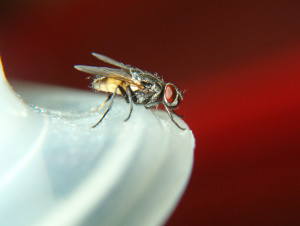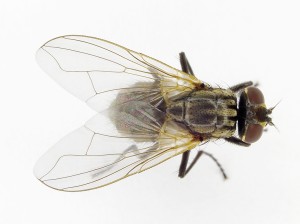
A global team of researchers, led by Jeffrey Scott at Cornell University, have successfully sequenced the house fly genome, published today in Genome Biology. In this guest post, Professor Scott tells us more about why the research represents a significant scientific advance.
An optimist is a fellow who believes a housefly is looking for a way to get out
George Jean Nathan
House flies are responsible for a great deal of human misery. They transmit over one hundred human diseases, including antibiotic resistance strains. Fly transmitted trachoma alone causes 6 million cases of childhood blindness each year. We hope that the house fly genome will open new opportunities for controlling this pest.
House fly larvae also live in a virtual sea of animal pathogens, and thrive there. This suggests that house flies have an immune system that is able to protect it in this highly septic environment.
The fly is also attacked by a number of parasitoids, including the wasp Nasonia vitripennis. The wasp’s genome was recently successfully sequenced, and with the completion of the house fly genome it will now be possible to study in great detail the comparative genomics of how a host and a parasitoid interact.

As well as these improvements to human health, the genome will provide insights that could help pest control. House flies rapidly evolve resistance to insecticides and this presents a major challenge to sustained control of this pest. The sequence of the genome will help us to identify the genes responsible for resistance more rapidly, and allow us to deploy appropriate resistance management tactics.
This will also provide us with valuable information about the molecular basis of resistance and how organisms adapt to toxic environments. It is possible that RNA interference (RNAi) could be used as a new method of pest control, perhaps in baits. The genome will provide the information necessary to screen targets for RNAi mediated control. Understanding more about the basis for sex determination in house flies, via the genome, may offer methods for non-chemical control of house flies, such as sterile male releases.
We also think the house fly genome will benefit the wider scientific community in several ways, by accelerating the pace of discovery. Genes can be readily amplified and cloned using the available sequence. People will no longer have to try and sequence genes based on homology with other species.
In our research, we compared the house fly genome to that of the fruit fly, Drosophila melanogaster, which is a well-studied model organism and is closely related to the house fly.
We were surprised to find that the genome size of the house fly is about five times larger than that of Drosophila melanogaster. We had not anticipated it would be quite this large.
When we looked in detail at the genes that made up the genome, we were able to see what kind of genes contributed to this much larger size. We found that house flies have more immune-related genes than Drosophila, consistent with the idea that they have a bolstered immune system to help them cope with living in a septic environment. They also have more metabolism or detoxification genes than Drosophila, suggesting that house flies are well adapted to dealing with toxins in their environment. We were surprised by just how many more house flies had. For example, house flies have 146 cytochrome P450 genes. This is much more than even its closest relative with a sequenced genome (tsetse fly) which has 72, or D. melanogaster which has 85.

Another reason their genome is so much larger, is that M. domestica has evolved an expanded repertoire of chemoreceptors and proteins associated with taste, specifically perception of bitter tasting compounds, compared with D. melanogaster.
Having the completed genome and using a relatively new technique, called bulk segregant analysis, it is possible to identify regions in the genome that have undergone a selective sweep. Using this technique will offer us new and valuable insights into the evolution of insecticide resistance. Which in turn, could help us to understand how to control house fly populations, and with them the spread of disease.
Latest posts by Guest (see all)
- Microbial forensics: It’s not just fingerprints that can be left behind - 12th May 2015
- How can ‘conservation genomics’ help the recovery of the most endangered species? - 12th December 2014
- Acetate helps hypoxic cancer cells get fat - 11th December 2014
Comments